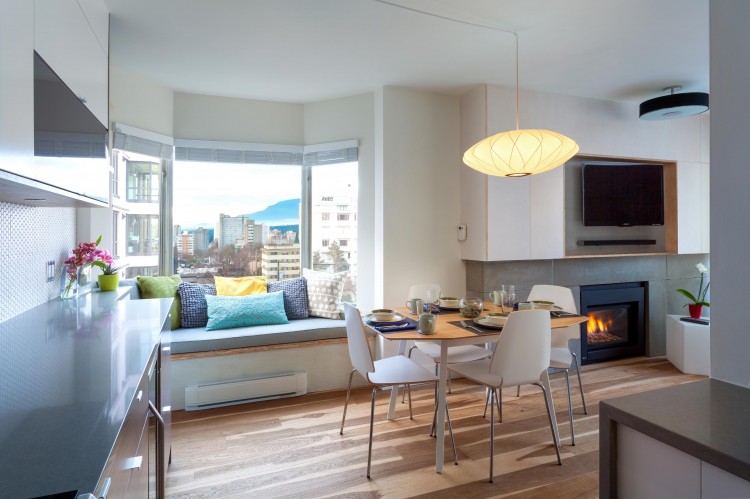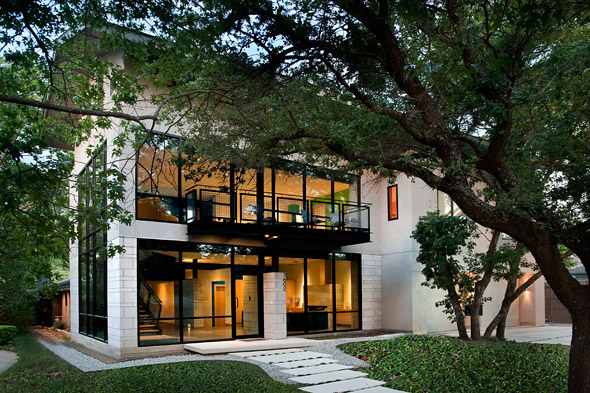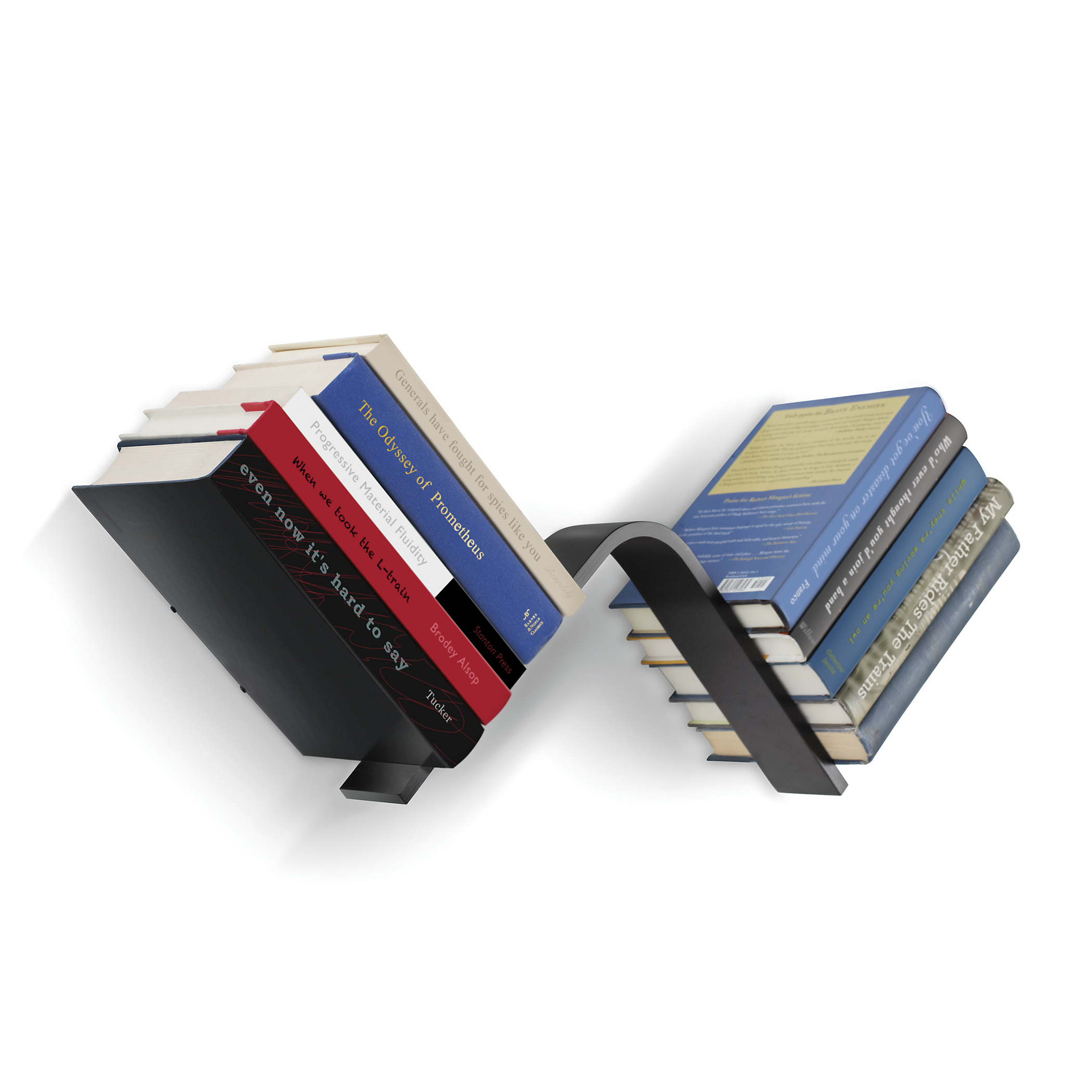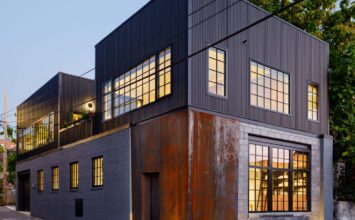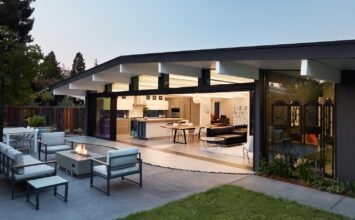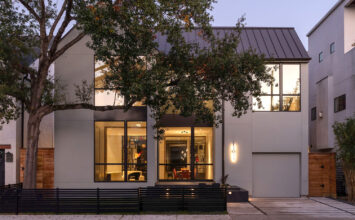
This weekend, Modern Home Tours returns to Vancouver, a city strongly rooted in design and urbanism. “Vancouverism,” the city’s unique brand of urban planning, plays out in a skyline of needle-tower condominiums whose narrow footprints and glass exteriors Douglas Coupland was evoking when he famously dubbed Vancouver the “City of Glass.”
As Vancouver continues to perfect high-density living, another housing typology is being embraced: Passive House, a smart way to build that prioritizes energy-efficiency and high-performance design. One of the biggest champions of Passive House is Allison Holden-Pope of One SEED Architecture + Interiors, a boutique firm that specializes in green and contemporary spaces, whose West End Nest Condo – a 1,000 square foot, 2-bed, 2-bath condo built by Vertical Grain Projects – will be featured on this weekend’s tour.
We sat down with Allison to talk about the West End Nest Condo and West Coast modern vernacular, healthy spaces and ecological footprints, and how Vancouver is embracing the Passive House.
Q&A w/ Allison Holden-Pope, One SEED Architecture + Interiors
You launched One SEED Architecture + Interiors, a boutique architecture firm that specializes in green and contemporary spaces, in 2008. What led you to create One SEED, and what’s the guiding philosophy?
As with many architecture firms, our creation story was one of great timing and of circumstances for which I would love to claim credit, but which were beyond my control. I was working in a commercial architecture firm when I was approached with the opportunity to design a custom ocean-front home on Saltspring Island, B.C. I took a short leave of absence from my position to focus on this dream project, and when I told my employer, he asked me to design a home for him while I was at it. Shortly thereafter a third project fell into my lap, and the leave of absence quickly became a start-up firm, and One SEED Architecture + Interiors was born.
Every architecture student goes through their school years dreaming of having their own firm one day. I was no different. I had notebooks filled with design concepts and ideas for my firm, so when the opportunity arose, I seized it. I had already chosen a name. SEED is an acronym for ‘sustainable’, ‘evocative’, ‘efficient’ and ‘distinct’, the four pillars of our firm’s practice.
One SEED is built on a strong foundation of technical knowledge and attention to detail. Our absolute passion for all things modern, innovative, and green is what keeps us going. We choose projects that inspire us. We are having fun, and we are constantly learning.

One of your biggest concerns is creating “healthy” spaces. What are the biggest factors that homeowners should have in mind when it comes to the ecological footprint of their home?
The short answer is energy efficiency. In Canada, 75% – 85% of the environmental impact of a home over its lifetime is the result of its heating and cooling energy. By targeting energy efficiency, we have the greatest impact on the ecological footprint of a home. We are currently working on two Passive House projects in Vancouver, and Passive House is, simply put, the smartest way to build. Passive House prioritizes energy efficiency with super-insulated walls, roofs, and floors, as well as high performance windows and doors. In combination with a design that is sensitive to the site and solar exposure, the house can almost heat and cool itself on its own.
There is a lot more to sustainability than just energy efficiency. Indoor air quality should be a priority for homeowners seeking a healthy space. The aggressive air tightness requirements of Passive House ensure that the air you breath is not coming through cracks in the wall, but is fresh filtered air delivered by an HRV. Beyond Passive House, the type of materials and objects we put in our home can have a detrimental impact on our health, with off-gassing being the biggest culprit.
Reduce, Reuse, Recycle. This applies to the construction materials, fixtures, and finishes in a home wherever possible. Reduce water consumption with efficient fixtures, rainwater capture, and native and drought-resistant plantings. Conserve energy beyond your heating and cooling loads with high-efficiency appliances, and low-consumption lighting fixtures and occupancy sensors. Using materials that have been salvaged or reclaimed not only reduces the damage caused by the extraction and processing of new materials, but also tells a story. When salvaged materials cannot be reused, favour materials with recycled content and made from sustainable sources such as rapidly renewable materials. A cradle-to-cradle approach to home building means that materials are also chosen for their ability to be repurposed at the end of their service life.
Last, but not least, durability is about more than using materials that will be around for a long time. It is about designing beautiful, well thought out spaces that people will want to hold onto for years to come.

You have said that your home that will be featured on the Vancouver Modern Home Tour “uses the vernacular West Coast Modern language.” What does this language mean to you?
West Coast Modern is soaring roof lines, post and beam houses tucked into old growth forests, and blurring the boundary between inside and outside. So, on the surface it does not have much to do with a condo on the fifth floor of an urban building. West Coast Modern is also about materials inspired by the rugged mountains and trees of our coastal climate. It uses light as a design element, and carefully frames views to create a connection to the outdoors. It is a language of mid-century pragmatism and simplicity, merged with contemporary geometry and clean lines.
The West End Nest Condo on the Modern Home Tour features warm wood accents, paired with cool earthy tones in tile and exposed concrete. The open concept kitchen, living, and dining are flooded with light. A window bench in a bay window frames the view to Stanley Park and the coastal mountains beyond. The living room opens on to a shallow balcony which is bordered in tall bamboo to extend the living space while creating a connection with nature.

This same home was also influenced by the character and materials of a converted New York loft. How did this design choice come about?
It is a condo after all, so I immediately thought of Europe and older cities like Montreal and New York, where they have perfected compact living spaces. I was inspired by my own travels to these places, as well as their well-documented images in magazines and design blogs. The ‘New York Loft’ aesthetic is a bit more DIY and exposed construction materials than the polished steel and glass towers that are currently going up in Vancouver. The West End Nest is not in a converted brick factory with 16′ ceilings, so the influence is more subtle. We white-washed plywood and used it for floating shelves and millwork, we scraped the concrete ceiling and painted it instead of cladding it with drywall, we designed an exposed concrete surround for the fireplace, we played with geometric tiles, and we tucked storage absolutely everywhere.

Hot on the heels of this year’s Vancouver Modern Home Tour is the White Rock Modern Home Tour. The shift in vibe from big-city to small-town really shines a light on where and how people chose to live. Your practice is based in a city rooted in “Vancouverism” and the notion that architecture builds the city. Who is your audience? Who are you, ideally, designing for?
We do not favour one lifestyle over another. Big city or rural setting, our projects are heavily influenced by their unique context. Our portfolio includes everything from downtown condos to laneway houses, to houses on standard 33’x122′ Vancouver lots, to cliff-hugging houses on the Sunshine Coast.
Our clients are first and foremost fun and friendly people who we like to spend time with. Residential design is a collaborative process, and it is extremely personal. We grow close with our clients over the design and construction process, so the compatibility of our personalities is as important as that of our design aesthetics. I have to say that it’s also a bonus when they are a bit quirky, as we love incorporating their hobbies or concepts for living into the space.
Our clients are also leaders and visionaries who care about sustainability and are motivated to make a change in their own backyard. They help us transform the market in support of green technologies and design strategies. We share a passion for modernism and the creative process.

With so many demographic shifts occurring in today’s world affecting how people live – technology, energy and environmental concerns, etc. – how do you see modern home design evolving in and around Vancouver?
I had the opportunity to speak at the BUILDEX Conference with three other local architects on exactly this subject in a presentation called ‘Smaller, Smarter, Shared’. We explored the new housing typologies that have emerged from Vancouver’s competitive and pricey real estate market. Density is undeniably a driving force, resulting in compact housing options that go beyond the condo, to laneway houses, micro-lofts, live-work spaces, and co-housing communities.
Multi-generational housing will likely continue to be more and more common as home owners use it as an opportunity to provide autonomy and care for aging parents, for the older generation to help out with child care, or as a way to lighten the financial burden when all generations contribute to housing costs.
We have noticed a definite shift in the Passive House movement, as it appears to have gained critical mass. For years, we have been introducing clients to Passive House, and now clients are coming to us looking for Passive Houses. This is undeniably the direction that new construction is headed. The City of Vancouver is embracing Passive House and supporting it as a way to promote high-performance construction.

Explore the West End Nest Condo in person — get your tickets to the Vancouver Modern Home Tour here!
